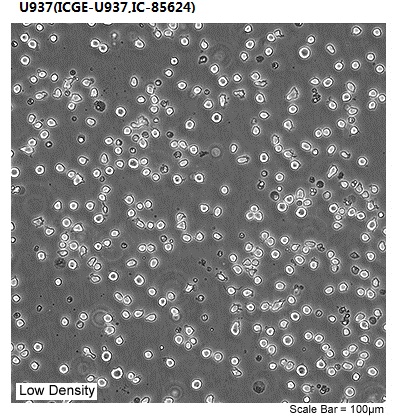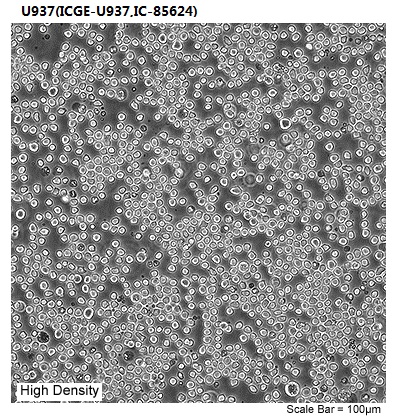


Overview
| Permits and Restrictions | |
|---|---|
| Organism | Homo sapiens, human |
| Tissue | Pleura/pleural effusion, lymphocyte, Myeloid |
| Product Format | frozen |
| Morphology | monocyte |
| Culture Properties | suspension |
| Biosafety Level |
1
Biosafety classification is based on U.S. Public Health Service Guidelines, it is the responsibility of the customer to ensure that their facilities comply with biosafety regulations for their own country. |
| Disease | histiocytic lymphoma |
| Age | 37 years |
| Gender | male |
| Ethnicity | Caucasian |
| Applications |
This cell line is suitable as a transfection host
|
| Storage Conditions | liquid nitrogen vapor phase |
Properties
|
|
|
|---|---|
| Derivation |
The U-937 cell line was derived by Sundstrom and Nilsson in 1974 from malignant cells obtained from the pleural effusion of a patient with histiocytic lymphoma.
|
| Clinical Data |
37 years
Caucasian
male
The U-937 cell line was derived by Sundstrom and Nilsson in 1974 from malignant cells obtained from the pleural effusion of a patient with histiocytic lymphoma.
|
| Receptor Expression |
complement (C3)
|
| Genes Expressed |
lysozyme; beta-2-microglobulin (beta 2 microglobulin); tumor necrosis factor (TNF), also known as tumor necrosis factor alpha (TNF-alpha, TNF alpha), after stimulation with phorbol myristic acid (PMA)
|
| Cellular Products |
lysozyme; beta-2-microglobulin (beta 2 microglobulin); tumor necrosis factor (TNF), also known as tumor necrosis factor alpha (TNF-alpha, TNF alpha), after stimulation with phorbol myristic acid (PMA)
|
| Comments |
Studies since 1979 have shown that U-937 cells can be induced to terminal monocytic differentiation by supernatants from human mixed lymphocyte cultures,
The cells are negative for immunoglobulin production and Epstein-Barr virus expression.
The cells express the Fas antigen, and are sensitive to TNF and anti-Fas antibodies.
In 1994, PCR and cytogenetic analyses showed that a number of stocks of U-937 were contaminated with the human myeloid leukemia cell line, K-562.
In the earliest stocks available, the level of contamination was 0.6%.
Distribution was discontinued in March 1994, except if required for patent purposes.
Anyone who wishes to receive a sample of this original material should contact the Head of the ATCC Patent Depository.
A stock of CRL-1593 found to be free of K-562 was propagated continuously for 8 weeks and tested weekly by PCR.
Distribution and seed stocks give DNA profiles characteristic of U-937 only.
Such preparations are now offered as authentic U-937 (ATCCCRL-1593.2) and are believed to be free of second subpopulations.
|
Background
| Complete Growth Medium |
The base medium for this cell line is ATCC-formulated RPMI-1640 Medium, ATCC 30-2001. To make the complete growth medium, add the following components to the base medium: fetal bovine serum (ATCC 30-2020) to a final concentration of 10%. |
|---|---|
| Subculturing |
Cultures can be maintained by the addition of fresh medium or replacement of medium. Alternatively, cultures can be established by centrifugation with subsequent resuspension at 1 to 2 X 105 viable cells/mL. Corning® T-75 flasks (catalog #431464) are recommended for subculturing this product.
Interval: Maintain cell density between 1 X 105 and 2 X 106viable cells/mL.
Medium Renewal: Add fresh medium every 3 to 4 days (depending on cell density)
|
| Cryopreservation |
Freeze medium: Complete growth medium supplemented with 5% (v/v) DMSO
Storage temperature: liquid nitrogen vapor phase
|
| Culture Conditions |
Atmosphere: air, 95%; carbon dioxide (CO2), 5%
Temperature: 37��C
|


